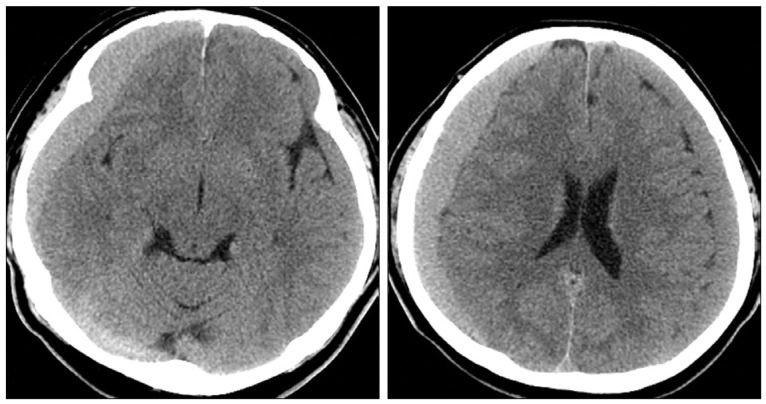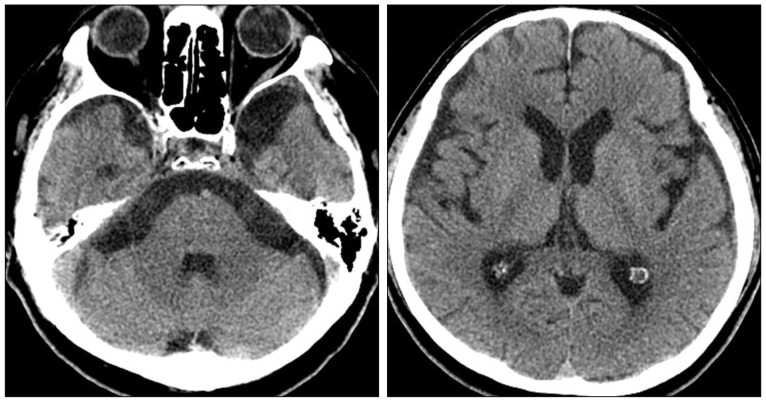J Korean Neurosurg Soc.
2013 Sep;54(3):265-267. 10.3340/jkns.2013.54.3.265.
Chronic Subdural Hematoma after Eccentric Exercise Using a Vibrating Belt Machine
- Affiliations
-
- 1Department of Neurosurgery, Soonchunhyang University Cheonan Hospital, Cheonan, Korea. ksleens@sch.ac.kr
- KMID: 2190912
- DOI: http://doi.org/10.3340/jkns.2013.54.3.265
Abstract
- We report a case of bilateral chronic subdural hematoma (CSDH) in a 75-year-old man after exercise using a vibrating belt machine on the head. He suffered from headache and intermittent left side numbness for ten days. He denied any head injuries except eccentric exercise using a vibrating belt on his own head for 20 days. An MRI revealed bilateral CSDH. The hematoma was isodense on the CT scan. We made burr-holes on the both sides under local anesthesia. We identified the neomembrane and dark red subdural fluid on both sides. In the postoperative CT scan, we found an arachnoid cyst on the left temporal pole. Although the arachnoid cyst itself is asymptomatic, trivial injury such as vibrating the head may cause a CSDH.
MeSH Terms
Figure
Cited by 1 articles
-
Spontaneous Disappearance of an Arachnoid Cyst after Burr Hole Drainage of Chronic Subdural Hematoma
Do-Yub Kim, Sungjoon Lee, Byung-Sam Choi, Jung-Soo Kim
Korean J Neurotrauma. 2019;15(2):159-163. doi: 10.13004/kjnt.2019.15.e15.
Reference
-
1. Adhiyaman V, Asghar M, Ganeshram K, Bhowmick B. Chronic subduFigral haematoma in the elderly. Postgrad Med J. 2002; 78:71–75. PMID: 11807186.2. Bradley W, Schmidt P. Effect of methemoglobin formation on the MR appearance of subarachnoid hemorrhage. Radiology. 1985; 156:99–103. PMID: 4001427.
Article3. Carmont M, Mahattanakul W, Pigott T. Acquisition of a chronic subdural haematoma during training for competitive race walking? Br J Sports Med. 2002; 36:306–307. PMID: 12145124.
Article4. De Cauwer H, Van Giel R, Mortelmans L, van den Hauwe L. An uncommon cause of headache after headbanging at a party. Eur J Emerg Med. 2009; 16:212–213. PMID: 19398915.
Article5. DeLaPaz RL, New PF, Buonanno FS, Kistler JP, Oot RF, Rosen BR, et al. NMR imaging of intracranial hemorrhage. J Comput Assist Tomogr. 1984; 8:599–607. PMID: 6736357.
Article6. Fernandes CM, Daya MR. A roller coaster headache : case report. J Trauma. 1994; 37:1007–1010. PMID: 7996597.7. Fukutake T, Mine S, Yamakami I, Yamaura A, Hattori T. Roller coaster headache and subdural hematoma. Neurology. 2000; 54:264. PMID: 10636168.
Article8. Geddes J, Tasker R, Hackshaw A, Nickols C, Adams G, Whitwell H, et al. Dural haemorrhage in non-traumatic infant deaths : does it explain the bleeding in 'shaken baby syndrome'? Neuropathol Appl Neurobiol. 2003; 29:14–22. PMID: 12581336.
Article9. Han JS, Kaufman B, Alfidi R, Yeung H, Benson J, Haaga J, et al. Head trauma evaluated by magnetic resonance and computed tomography : a comparison. Radiology. 1984; 150:71–77. PMID: 6689790.
Article10. Hosoda K, Tamaki N, Masumura M, Matsumoto S, Maeda F. Magnetic resonance images of chronic subdural hematomas. J Neurosurg. 1987; 67:677–683. PMID: 3668635.
Article11. Keller TM, Holland MC. Chronic subdural haematoma, an unusual injury from playing basketball. Br J Sports Med. 1998; 32:338–339. PMID: 9865409.
Article12. Türkoğlu E, Serbes G, Sanli M, Sari O, Sekerci Z. Chronic subdural hematoma in capoeira sport. Turk Neurosurg. 2008; 18:39–41. PMID: 18382976.13. Logan SM, Bell GW, Leonard JC. Acute subdural hematoma in a high school football player after 2 unreported episodes of head trauma : a case report. J Athl Train. 2001; 36:433. PMID: 12937485.14. Pfister BJ, Chickola L, Smith DH. Head motions while riding roller coasters : implications for brain injury. Am J Forensic Med Pathol. 2009; 30:339. PMID: 19901817.15. Roldan-Valadez E, Facha M, Martinez-Lopez M, Herrera-Mora P. Subdural hematoma in a teenager related to roller-coaster ride. Eur J Paediatr Neurol. 2006; 10:194–196. PMID: 16949843.
Article16. Snyder RW, Sridharan ST, Pagnanelli DM. Subdural hematoma following roller coaster ride while anticoagulated. Am J Med. 1997; 102:488. PMID: 9217648.
Article17. Zeng T, Shi SS, Lin YF. Chronic subdural hematoma associated with sylvian arachnoid cyst in juvenile athletes : report of two cases and literature review. Chin J Traumatol. 2011; 14:174–177. PMID: 21635806.
- Full Text Links
- Actions
-
Cited
- CITED
-
- Close
- Share
- Similar articles
-
- Chronic Subdural Hematoma Superimposed on Posttraumatic Subdural Hygroma: A Report of Three Cases
- Bilateral Acute Subdural Hematoma Following Evacuation of Chronic Subdural Hematoma
- Treatment of Chronic Subdural Hematoma with Arachnoid Cyst
- Chronic Subdural Hematoma with Calcification: Case Report
- Intraoperative Development of Contralateral Subdural Hematoma during Evacuation of Acute Subdural Hematoma: Case Report






